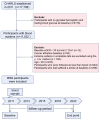Predictive value and robustness of the stress hyperglycemia ratio combined with hypertension for stroke risk: evidence from the CHARLS cohort
- PMID: 40826075
- PMCID: PMC12363087
- DOI: 10.1186/s12933-025-02898-z
Predictive value and robustness of the stress hyperglycemia ratio combined with hypertension for stroke risk: evidence from the CHARLS cohort
Abstract
Background: Stroke remains a major cause of death and long-term disability worldwide, particularly in low- and middle-income countries. Early identification of individuals at high risk is essential for prevention. The stress hyperglycemia ratio (SHR), a novel indicator integrating acute and chronic glycemic states, has shown prognostic value in acute illness. However, its association with stroke risk in community populations and its potential interaction with hypertension remain unclear.
Methods: This retrospective cohort study included 9682 stroke-free participants aged ≥ 45 years from the 2011 baseline of the China Health and Retirement Longitudinal Study (CHARLS), followed through 2020. SHR was calculated using fasting blood glucose and glycated hemoglobin. Participants were categorized by median SHR and hypertension status into four groups. Cox proportional hazards models were used to assess associations with incident stroke over a median follow-up of 8.43 years. Subgroup, stratified, and sensitivity analyses were performed. Predictive performance was evaluated using receiver operating characteristic (ROC) curve analysis.
Results: During 81,601 person-years of follow-up, 764 incident stroke cases were documented, with an overall incidence of 9.36 per 1000 person-years. Compared to the reference group (low SHR without hypertension), those with high SHR and hypertension had the highest stroke risk (hazard ratio: 2.94, 95% confidence interval: 2.38-3.64). SHR and hypertension were independently associated with stroke risk, and their combination demonstrated a dose-response relationship. Subgroup analyses confirmed consistent findings across sex and age strata. The combined SHR-hypertension model showed improved discriminative ability (area under the ROC curve: 0.653). Sensitivity analyses confirmed the robustness of the results.
Conclusions: Elevated SHR is independently associated with an increased risk of stroke, and its predictive value is enhanced when combined with hypertension. SHR may serve as an integrated metabolic marker reflecting both acute stress and chronic risk burden. Incorporating SHR into stroke risk assessment tools may improve early identification and enable more targeted prevention strategies, particularly in hypertensive populations.
Keywords: CHARLS; Cohort study; Hypertension; Metabolic stress; Risk prediction; Stress hyperglycemia ratio; Stroke.
© 2025. The Author(s).
Conflict of interest statement
Declarations. Ethics approval and consent to participate: The CHARLS study adheres to the principles of the Declaration of Helsinki and was approved by the Institutional Review Board of Peking University (IRB00001052-11015). All participants provided written informed consent prior to participation. This study follows the Strengthening the Reporting of Observational Studies in Epidemiology (STROBE) guidelines for observational research. Consent for publication: All authors have read and approved the manuscript for submission to this journal. No part of this work has been published or is under consideration elsewhere. Competing interests: The authors declare no competing interests.
Figures



Similar articles
-
Prescription of Controlled Substances: Benefits and Risks.2025 Jul 6. In: StatPearls [Internet]. Treasure Island (FL): StatPearls Publishing; 2025 Jan–. 2025 Jul 6. In: StatPearls [Internet]. Treasure Island (FL): StatPearls Publishing; 2025 Jan–. PMID: 30726003 Free Books & Documents.
-
Comparison of Two Modern Survival Prediction Tools, SORG-MLA and METSSS, in Patients With Symptomatic Long-bone Metastases Who Underwent Local Treatment With Surgery Followed by Radiotherapy and With Radiotherapy Alone.Clin Orthop Relat Res. 2024 Dec 1;482(12):2193-2208. doi: 10.1097/CORR.0000000000003185. Epub 2024 Jul 23. Clin Orthop Relat Res. 2024. PMID: 39051924
-
Are Current Survival Prediction Tools Useful When Treating Subsequent Skeletal-related Events From Bone Metastases?Clin Orthop Relat Res. 2024 Sep 1;482(9):1710-1721. doi: 10.1097/CORR.0000000000003030. Epub 2024 Mar 22. Clin Orthop Relat Res. 2024. PMID: 38517402
-
Replacing salt with low-sodium salt substitutes (LSSS) for cardiovascular health in adults, children and pregnant women.Cochrane Database Syst Rev. 2022 Aug 10;8(8):CD015207. doi: 10.1002/14651858.CD015207. Cochrane Database Syst Rev. 2022. PMID: 35944931 Free PMC article.
-
Undernutrition as a risk factor for tuberculosis disease.Cochrane Database Syst Rev. 2024 Jun 11;6(6):CD015890. doi: 10.1002/14651858.CD015890.pub2. Cochrane Database Syst Rev. 2024. PMID: 38860538 Free PMC article.
References
-
- Gorelick PB. The global burden of stroke: persistent and disabling. Lancet Neurol. 2019;18(5):417–8. - PubMed
-
- Global incidence, prevalence, years lived with disability (YLDs), disability-adjusted life-years (DALYs), and healthy life expectancy (HALE) for 371 diseases and injuries in 204 countries and territories and 811 subnational locations, 1990–2021: a systematic analysis for the Global Burden of Disease Study 2021. Lancet. 2024; 403(10440):2133–2161. - PMC - PubMed
-
- Golubnitschaja O, Potuznik P, Polivka J Jr, Pesta M, Kaverina O, Pieper CC, Kropp M, Thumann G, Erb C, Karabatsiakis A, et al. Ischemic stroke of unclear aetiology: a case-by-case analysis and call for a multi-professional predictive, preventive and personalised approach. Epma J. 2022;13(4):535–45. - PMC - PubMed
-
- Krishnamurthi RV, Ikeda T, Feigin VL. Global, regional and country-specific burden of ischaemic stroke, intracerebral haemorrhage and subarachnoid haemorrhage: a systematic analysis of the Global Burden of Disease Study 2017. Neuroepidemiology. 2020;54(2):171–9. - PubMed
Grants and funding
- 2025ZZTS0973/2025 Central South University Graduate Student Independent Exploration and Innovation Project
- 202424/"Co-PI" project from The Third Xiangya Hospital of Central South University
- 2024JJ5520/Natural Science Foundation of Hunan Province
- kq2403054/Changsha Municipal Natural Science Foundation
- 20240101-20261230/Hunan Provincial Program for Young Key Teachers in Universities
LinkOut - more resources
Full Text Sources

